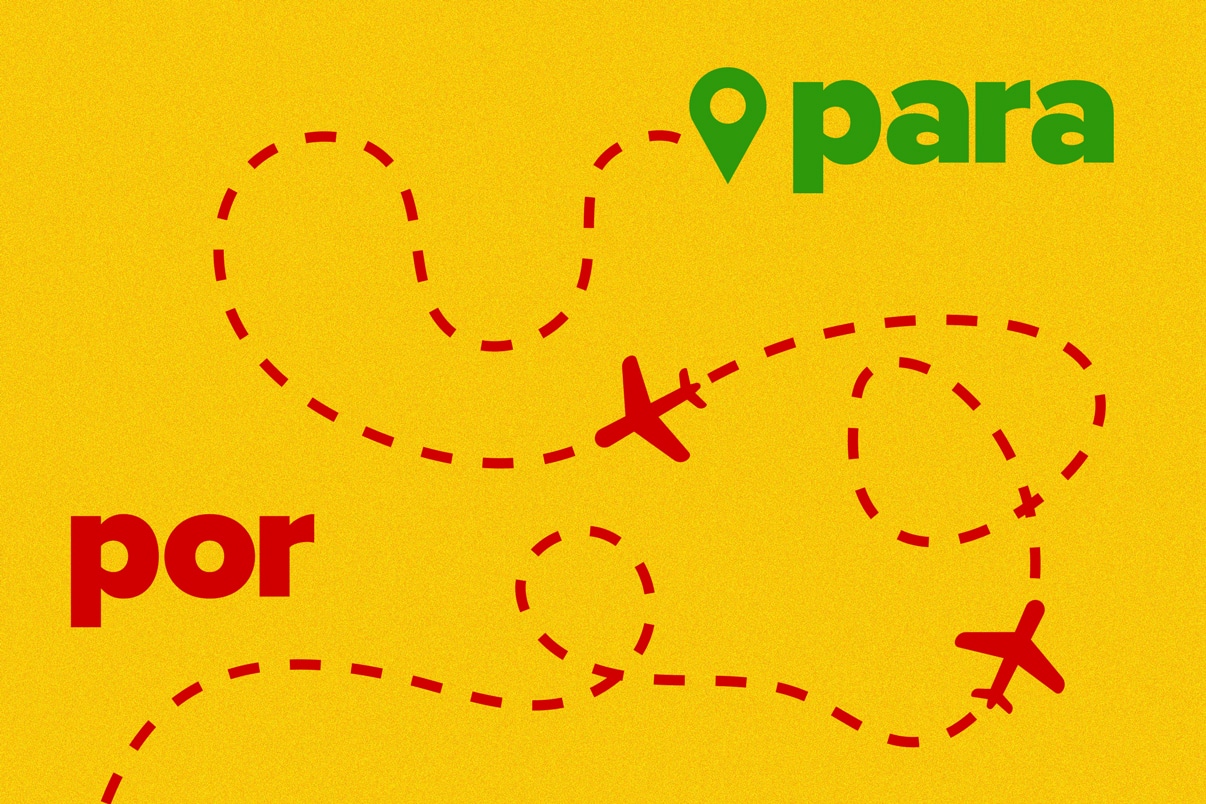
Knowing the difference between por and para can be a tricky issue for most Spanish learners. Both can mean “for,” but they’re used in different situations.
Por is used for reasons, communication, travel, how long something goes on, transactions, substitutes and favors.
Para is used when talking about recipients, destinations, goals, opinions and deadlines.
Read on to learn all about when to use each word plus 20 expressions that contain one or the other.
Contents
Download:
This blog post is available as a convenient and portable PDF that you
can take anywhere.
Click here to get a copy. (Download)
Por Versus Para
Here is more about these differences:
Use por when:
- Indicating the reason for doing something. You can translate it to “because of”:
No ha venido por el mal tiempo. (He has not come because of the bad weather.)
- You want to talk about communication and travel:
Me contestó por email. (He answered me via/by email.)
Nunca he viajado por Polonia. (I have never traveled through Poland.)
- You need to state how long something goes on:
Estuve escribiendo por 3 horas. (I was writing for 3 hours.)
- You want to refer to an exchange or transaction:
¿De verdad has pagado tanto por ese teléfono? (Have you really paid that much for that phone?)
Me dio su camiseta por mi camisa. (She gave me her T-shirt for my shirt.)
- One person substitutes or takes the place of another during a task:
Fui a ayudar por mi padre. (I went to help instead of my father.)
- You do something for someone out of love:
Todo esto es por ti. (All this is for you.)
Use para when:
- You need to talk about the recipient of something:
Esto es para ti. (This is for you.)
- You are referring to a destination or final point:
El tren para Lisboa sale en 3 minutos. (The train to Lisbon leaves in 3 minutes.)
- You want to talk about goals and purpose:
Hemos venido para almorzar contigo. (We have come to have lunch with you.)
- You want to give your opinion or talk about someone else’s opinion:
Para mí, esta casa es muy pequeña. (For me, this house is very small.)
Para mi madre, eso es muy peligroso. (According to my mother, that is very dangerous.)
- You have to talk about or discuss a deadline:
Lo necesito para el lunes. (I need it for Monday.)

Spanish Expressions with Por
- Por ahora (for now) — Por ahora, todo está controlado. (Everything is under control for the time being.)
- Por completo (completely, absolutely) — Se le olvidó por completo. (He completely forgot about it.)
- Por ejemplo (for example) — Juan y Pedro, por ejemplo. (Juan and Pedro, for example.)
- Por favor (please) — Ayúdame, por favor. (Help me, please.)
- Por fin (finally, at last) — ¡Has vuelto! ¡Por fin! (You are back! At last!)
- Por lo menos (at least) — Necesito tres por lo menos. (I need three at least.)
- Por lo visto (apparently) — Por lo visto, él le ha sido infiel. (Apparently, he has cheated on her.)
- Por si acaso (just in case) — Vamos a volver por si acaso. (Let’s go back, just in case.)
- Por supuesto (sure, of course) — ¡Por supuesto que no lo haré! (Of course I will not do it!)
- ¿Por qué? Porque… (why? because…) — ¿Por qué lloras? Porque estoy triste. (Why are you crying? Because I am sad.)
- Gracias por (thanks for) — Gracias por todo, mamá. (Thanks for everything, mum.)
Spanish Expressions with Para
- Para colmo (to top it all) — Llegó tarde y, para colmo, no pidió disculpas. (He arrived late and, to top it all, he did not apologize.)
- Para empezar (for starters) — Para empezar, vamos a llamar a papá. (For starters, let’s call dad.)
- Para entonces (by then) — Ya había muerto para entonces. (He was dead by then.)
- Para nada (not…at all) — No me gusta para nada. (I do not like it at all.)
- Para otra vez (for another time, for another day) — Dejémoslo para otra vez. (Let’s leave it for another time.)
- Para que / para qué (so that, in order to / what for) — Lo hice para que vinieras. (I did it so that you would come.)
- Para siempre (forever) — Quiero estar contigo para siempre. (I want to be with you forever.)
- Para variar (as usual, just for a change) — Has vuelto a mentir, para variar. (You have lied again, just for a change.)
- Estar para (to be about to) — Estaba para salir cuando llamaste. (I was about to go out when you called.)
Para mí vs. Por mí
Para mí and por mí are a special case because they not only have a difference in meaning, but they themselves also change meanings depending on where you put them in a sentence.
On the one hand, para mí at the beginning of a sentence means “in my opinion.”
- Para mí, ese niño es muy inteligente. (In my opinion, that boy is very intelligent.)
- Para mí que está cansado. (In my opinion, he is tired.)
When added at the end of a sentence, para mí changes its meaning to “for me” (in contexts when we receive something):
- Este regalo es para mí. (This present is for me.)
- El café también es para mí. (The coffee is also for me.)
On the other hand, por mí at the beginning of a sentence means “as far as I am concerned” or “as for me,” and it adds a sense of indifference to the whole:
- Por mí como si no vuelve. (As for me, he may well never come back.) [And I don’t care.]
- Por mí que lo metan en la cárcel. (As far as I am concerned, they can put him in jail.)
Finally, por mí at the end of a sentence loses its indifference, and it comes to mean “instead of me,” “in my place” or “for me” (with the meaning of “for my sake”):
- Irá de compras por mí. (He will go shopping in my place.)
- Me dijo la verdad por mí. (He told me the truth for my sake.)
¿Para qué? vs. ¿Por qué?
Para qué and por qué are not as changeable as para mí and por mí, but they also have a difference in meaning.
We use para qué when we want to ask for what purpose something was done:
- ¿Para qué has comprado eso? (What have you bought that for?)
- ¿Para qué vienes? (For what purpose are you coming?)
On the other hand, ¿por qué? (not to be confused with the other porques) means “Why?” or “For what reason?”
- ¿Por qué has venido tan temprano? (Why have you come so early?)
- ¿Por qué te vas? (Why are you leaving?)
You may think that their meaning is too close, even related, since asking for a reason and asking for a purpose are definitely connected. However, there are situations when it is very obvious that you need to use the right one.
¿Por qué no? vs. ¿Para qué no?
¿Por qué no? is used to ask for the reason “why not”:
- ¿Por qué no comes pizza? (Why don’t you eat pizza?)
- ¿Por qué no me hablas? (Why don’t you talk to me?)
¿Para qué no? is a question that follows a negative statement or command. For example:
- No uses eso para comer (Don’t use that for eating.)
- ¿Para qué no debo usarlo? No te he oído. (What shouldn’t I use it for? I didn’t hear you.)
Where to Practice Por vs Para
These resources can help you practice the difference between por and para.
SpanishDict

This 40-question por vs para quiz will help you assess your knowledge in no time.
Every time you answer a question, you get instant feedback and a grammar explanation.
FluentU

FluentU allows you to see how natives actually use por and para with video clips of movies, TV shows, news, etc.
You can even use interactive subtitles, flashcards and quizzes to test your retention.
FluentU is available on iOS and Android.
A Green Mouse

This site gives you a wide range of exercises, grammar explanations, videos and quizzes on por versus para.
And here are some additional tips for practicing por versus para:
- Do exercises and take quizzes. This will help you apply the words and remember them better.
- Write down lots of por and para sentences. This will help you start seeing patterns and expressions that repeat themselves so you learn faster.
- Create your own flashcards. This way, your por and para sentences will be with you all the time.
- Read a lot. Context is everything, and reading will give you plenty of real Spanish to gorge on.
- Listen to Spanish podcasts. Listening to podcasts will allow you to hear these prepositions used in natural speech.
- Watch Spanish movies, series and YouTube videos. Watching any kind of video material with native Spanish in it will have a similar effect as listening to podcasts.
- Try to use por and para whenever you can. Write in Spanish online chats, talk to friends in Spanish, talk to yourself in the mirror, etc.
Now you know a little more about how to tell the difference between por and para.
Keep practicing and soon it will be all the easier to use them correctly!



